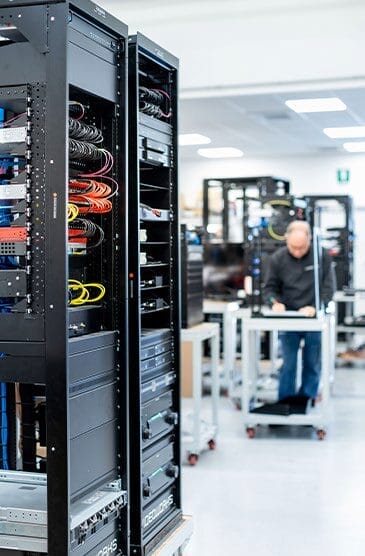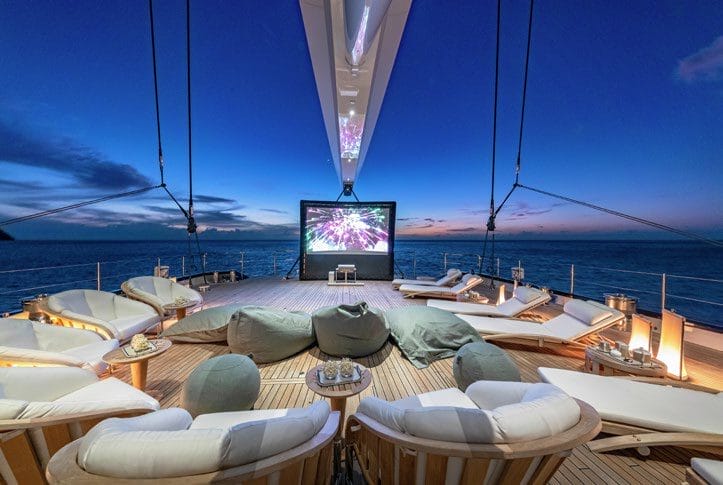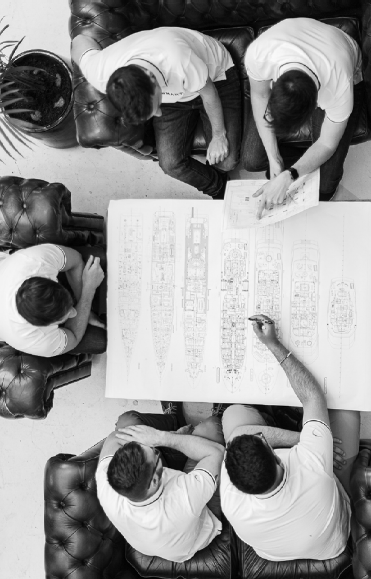Ask the
Expert: AV/IT.
As technology has developed and the focus of owners has shifted, AV/IT has been gaining in importance resulting in bespoke, multi-million euro contracts. Today, the AV/IT sector is streamlining its approach to simplify some of the complexities of onboard technology. To tell us more about the latest developments we sat down with Arjan Kleinveld, managing partner of ONE XP; Diego Tavaroli, yachting systems engineer at Videoworks; Jeroen van den Hurk, CEO at Van Berge Henegouwen (VBH); Zeb Robin, technical director at Bond Technology Management; and Tom Richardson, chief technology officer, Smart Technology Advisers.

Technology is developing all the time. How do you future-proof an AV/IT system?
Jeroen van den Hurk: Future-proofing an AV/IT system in the rapidly evolving technology landscape requires a multifaceted approach. You should prioritise a smart system architecture that leverages a robust, tested, and certified cabling infrastructure and IT backbone. Ensuring the yacht has the right type and sufficient amount of cabling is crucial for seamless upgrades and accommodating new technologies without extensive overhauls. While this foundation is essential, it requires some regular upgrades to allow our clients to continuously benefit from the latest innovations.
Zeb Robin: Bond TM has a fundamentally different perspective than an integrator, as our position working directly for yacht owners means we can drive the specification to ensure systems are future proofed. Integrators must bid on specifications, we write them. On a more specific level, we’re always looking 10-15 years ahead to make sure the systems we design are future proof. Additionally, we are encouraging yacht owners to simplify and streamline their systems so that long-term maintenance and operational costs are reduced. Starlink was the lynchpin we were waiting forto fundamentally re-invent the onboard AV/IT systems we tailor to owners’ needs.
Tom Richardson: The “art” of future proofing a system on any marine vessel is not having to loop back and modify the core infrastructure. End user items and
visible items such as displays are very simple, latestage upgrades. We take a holistic view on this; the builder has a contractual obligation to build a luxury assetand the earlier the builder can gather information on infrastructure the better it is for all parties. While developing the GA with the designers, engineers,
architects, and builders, we are allowing for space, cooling, routing, electrical loads and positioning of major items. We always allow for “headroom” in any
system. The simple answer is to be deliberate in your goal, design the system with overcapacity in the most cost-effective and least disruptive way possible; that way you get little resistance from any party.
Arjan Kleinveld: The most important thing is to ensure that the infrastructure and build process allows for changes that don’t affect the physical integration too much. Changes that demand new cabling, for example, will cause more work, so working with an experienced advisor who have the experience to recognise the trends and to manage expectations is vital. If a clear decision timeline is explained and shared with all relevant parties, we don’t see hurdles, while the client
understands he has the latest and greatest. Again, this should still allow for changes and added functionality without affecting the physical side of the installation.

What is your advice for project managers or owners’ reps tasked with choosing an integrator and speccing a system?
Tom Richardson: Any owner will have key likes and dislikes; always focus onthe dislikes first as those are the experiences we need to never repeat. Next stage is the key “must haves”, the complexity and size of the system, the capability of the builder and, of course, budget. Depending on time available and the stage you are at in the build, the more detailed the specification is, and the more things that can be defined at an early stage, then the more secure the budget, as the
integrator will not be adding contingency costs for unknowns. Multi-million-dollar systems are not uncommon so a contingency of only 5 per cent is a substantial sum. Once you know the budget and the complexity then you will, by default, be left with a shortlist of experienced, well-funded and known
integrators. Remember: it’s people that build yachts. You canget what you think is the right supplier but may get their “B” team, so make sure they have the resources available to do your build.
Jeroen van den Hurk: The complexity and cost of AV/IT systems are often driven by the high expectations and specific requirements of the client. The paradox here is that clients typically desire the latest and greatest technologies, but not a “me too” system. Therefore, speccing a system to the smallest detail and benchmarking on price will not push integrators to offer the creativity that is so highly valued by the clients. Our main advice to project managers and
owners’ reps is to engage with multiple system integrators at an early stage and listen to their ideas on the added value each one can bring beyond standard hardware integration.
Zeb Robin: We respectfully challenge the assumption that AV/IT systems must be complex and costly. There is a clear trend towards simplification which we at Bond are leaning into, and it is possible today to simultaneously shrink systems and future proof them. One should first make sure a good team is creating the system specification packages. If you are considering bringing expert consultants onto your team, then scratch the surface to ensure their merit and avoid cronyism. It takes time to build a good specification, and cutting corners at early stages can be costly in the end. Next, there has been a downsizing trend
in the last decade, which has allowed us to return space back to the interior, but it relies on good communications with the owner in terms they can relate to. If you ask an integrator or anyone really who doesn’t know the client, you will get over-spec’d systems containing everything plus the kitchen sink. However, the systems we’ve been working with our customers to specify are smaller, cooler and more capable than those of the past, because customers today are rejecting a lot of the complexity which in the past was under-utilised or never used at all.
Some superyachts now have a full-time ETO (Electro Technical Officer) on board. Is there sufficient training for crew to run and maintain the AV/IT systems properly?
Jeroen van den Hurk: AV/IT maintenance and service are essential for the stability and uptime of onboard systems. We recognise the
critical role of the Electro Technical Officer (ETO) and provide comprehensive training and ongoing support to ensure they can effectively manage these systems. Our training programs cover the installation, operation, and basic troubleshooting of new systems, ensuring that the ETO and relevant crew members are well-prepared from the start. There is always something to learn and always something to do, and our team is dedicated to providing continuous education and support to keep the systems running smoothly.
Arjan Kleinveld: There are specific AV/IT training possibilities. Depending on the ETO’s background, generic IT training (such as CCNA or CompTIA A+) can build the knowledge bases and basic Crestron training. To dive deeper into the specifics, reliance on an AV/IT integrator’s hands-on training, or one of the shore-based training courses specific for maritime AV/IT, can be valuable for fulfilling the role within the ETO job profile.

In an increasingly connected environment, how important is it to have a cybersecurity management plan when designing an onboard IT system?
Tom Richardson: Having a plan is strongly recommended as part of the ISM Code for almost all yachts. There are two pieces of legislation relating to cybersecurity, the first being IMO Resolution MSC.428(98) which has been in force since January 2021. This lays the foundation for what each yacht should have in place in terms of planning, how they verify and how they act if there is a cybersecurity event or breach. This is strongly recommended as cybersecurity breaches can have both a large operational and financial impact to the vessel, but also potential reputational damage to the owner or their assets.
The second piece of legislation is known as IACS UR E26 and UR E27. These are IACS Unified Requirements and therefore will be adopted by each classification society. For larger yachts classed as ‘passenger yachts’ (e.g. REG Yacht Code Part B vessels) the legislation is compulsory for any new-build contract signed on or after 1st July 2024. This latter piece of legislation is a step change in the marine industry and something we welcome. It now puts the (cyber)security of systems installed on board yachts as a primary consideration, rather than an afterthought as is all too common in our industry sadly.
Zeb Robin: A Cyber Security Management Plan is a vital operational matter that crew must attend to, but it is not a tangible thing one can design into a system or pay cash up front for. If experts have designed the IT system to adequate standards using sound best practices while not cutting corners, then it will be possible to operate it safely and securely. However, a system packed with the most exotic security technologies in the world will amount to nothing if it gets hacked due to being operated and maintained incorrectly, or because the crew was not trained adequately to understand and avoid cyber threats. If the worst does come to pass and there is a cyber incident, the crew need to have a good plan they can follow to ensure they immediately do the right things to mitigate harm and/or loss, while quickly bringing the vessel back to a secure state. This is what good cyber policies and plans can do, but daily vigilanceis needed in the face of the threats out there, and a well-prepared crew is the first and best line of defence.
“Will traditional geostationary VSAT die out? That’s the million-dollar question.”
Diego Tavaroli: Yachts are prime targets for cyberattacks, whether for financial gain or other reasons. It’s crucial to protect both sensitive information and operational systems that run the vessel. The information at risk includes data related to the crew, the vessel, and potentially valuable information about the owner(s), their businesses, and assets. As almost everything onboard becomes connected to the internet we must plan to protect various operational systems.
Unauthorised access to these systems could disrupt onboard operations to a great degree. Cyber security needs to be thought of during the design phase, all through the build of the vessel and continuously during the operation of the vessel.
Fast connectivity at sea can be elusive. Are 5G, Starlink and other low earth orbit satellites taking over from traditional VSAT technology?
Jeroen van den Hurk: While traditional VSAT technology is still widely used, the advent of 5G, Starlink, and other LEO satellites has significantly transformed maritime connectivity. These new technologies offer faster speeds, lower latency, and global connectivity, making them highly appealing options. Currently, a wider adoption of these new systems would require the launch of more satellites and the installation of new equipment on yachts. Additionally,
appropriate regulatory frameworks must be established. As a result, while VSAT technology remains relevant, the shift towards 5G and LEO satellite technologies is accelerating and is likely to continue, all to the benefit of a superior online experience at sea.
Tom Richardson: Starlink certainly took the industry by storm with their direct-toconsumerbusiness model, and they can be seen as a true disrupter. However, it’s important to mix your ‘sources of internet’ as no provider is 100 per cent reliable and outages can happen, so you must have a fallback plan in place. Another important issue to consider is availability and whether you have committed bandwidth. LEO satellites generally cover the whole globe (depending on their inclination) but that doesn’t mean you can access them globally – a lot is done with local licensing on a country-by-country basis, so it’s important to check that the service is available in the areas you plan to sail. If it isn’t, you then need to rely on that secondary system or provider. Will traditional geostationary VSAT die out? That’s the million-dollar question. I think we will see it used less and less and certainly if it is used, the CIR rate that yachts subscribe to will become lower. On the flip side, that may mean wholesale bandwidth costs come down, so some resurgence in the future is likely with a new price point per Mbps compared with today.

AV/IT upgrades are commonly requested during refit or maintenance periods when time is limited. What do crew and shipyards need to be aware of?
Zeb Robin: Firstly, if the vessel has good infrastructure (quality cabling, well built and cooled technical racks, etc.) then absolute refit costs will be much lower over time. It costs a bit more upfront to build good infrastructure, but it pays off in savings later, while increasing the longevity and reliability of all systems. Therefore, if the vessel’s infrastructure is poor, with intermittent faults and outages, overheating equipment, and so on, it may be a wise long-term investment to improve said infrastructure. Next, to get the best prices and ensure a smooth refit period, start developing your scope of work early and be realistic. Instead of trying to do everything at once, we have seen a trend with several customers whereby they prefer to develop an evolutionary upgrade strategy for their vessel with us. By breaking the upgrades into discrete chunks of work, it can result in lower costs and higher quality outcomes which don’t require the vessel to be out of service for any one long block of time. Lastly, logistical aspects such as hardware lead times, labour logistics and access to refit shipyards should not be underestimated. When these things go wrong they can cripple a refit, so they are best considered well in advance.
Tom Richardson: I think the phrase that sums this up is “manage expectations and not over-promise or under-deliver. Unless the crew and integrator have been involved from the original build then you cannot possibly know the capabilities of the “as-built system”. We have experienced situations whereby the crew quite innocently, and with the best intentions, get an indicative cost for the upgrade, give this to the owner, only to then find that the infrastructure and modifications required to accommodate the promised upgrade exceeds the component cost and the budget spirals out of control. Times hould be taken to look at infrastructure first and foremost, and if needed, phase in the upgrade(s). Do something tangible, whether that be a significant upgrade in a single space, Wi-Fi or communication. If theowner sees a step change in performance orenjoyment of the space or feature, then they will almost certainly continue to plan the next phase.
Arjan Kleinveld: A refit needs some flexibility from all parties involved, while the overall responsible party might be less clear. So make sure you have commitment on this and control over it. Look at the process, what do I get when, and what if the interior isn’t finished on time, etc. Foresee it together and make the necessary steps to mitigate those risks.
Diego Tavaroli: You should be clear about the expectations of the refit, planning ahead and providing information as it becomes available. We often receive refitting requests when the ship is already on site with very short lead times to complete it, without considering that procurement and engineering take time. Usually, a good new-build AV/IT project already takes into consideration a refit in 3/5/10 years, according to the used technologies onboard and the intended use of the yacht.
SOURCE : SUPERYACHT TIMES







